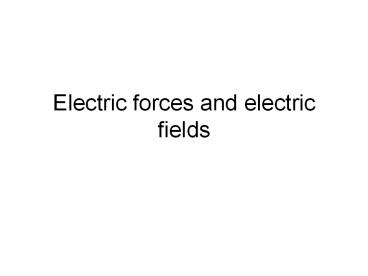Electric forces and electric fields - PowerPoint PPT Presentation
Title: Electric forces and electric fields
1
Electric forces and electric fields
2
- 1Proprieties of electric charges
- (Give an ex. of electrically charged)
- Electric charge can be or
- Like charges repel one another and unlike
charges attract one another - Electric charge is always conserved
- The object become charged because charge is
transffered from one object to another - An object may have charge of e, 2e, 3e
- e 1.60219x10-19C
- SI unit C (Coulomb)
3
- 2 Insulators and conductors
- In conductors, electric charges move freely in
response to an electric force. All other
materials are called insulators (give an ex. of
each) - Semiconductors are between conductors and
insulators. - An object connected to a conducting wire buried
in the Earth is said to be grounded. - Induction charging of a conductor
4
- Charging an object by induction requires no
contact with the object inducing the charge. - 3. Coulombs Law
- An electric force has the following properties
- It is directing along a line joining the two
particles and is inversely proportional to the
square of the separation distance r, between them
5
- It is proportional to the product of the
magnitudes of the charges, q1and q2, of the 2
particles - It is attractive if the charges are of the
opposite sign, and repulsive if the charges have
the same sign - The magnitude of the electric force
- Fke (q1q2/r2)
- ke Coulomb constant
- ke 8.9875x109N m2/C2
6
- 4. Electric Field
- The electric field E produced by a charge Q at
the location of a small test charge qo is
defined as the electric force F exerted by Q and
qo divided by the charge qo . - EF/qo Eke (q/r2)
- Si unit N/C
7
- Pb. Strategies
- 1. Draw a diagram of the charges
- 2. Identify the charge of interest
- 3. Convert all units in SI
- 4. Apply Coulombs Law
- 5. Sum all the x- components of the resulting
electric force - 6. Sum all the y-components of the resulting
electric force - 7. Use Pythagorean theorem to find the magnitude
and the direction of the force
8
- 5. Electric field lines
- 1. The electric field E is tangent to the
electric field lines at each point - 2. The number of lines per unit area through a
surface perpendicular to the lines is
proportional to the strength of the electric
field in a given region - Rules for drawing electric field lines
- -The lines for a group of point charges must
begin on charge and end on charge - - The number of lines drawn leaving a charge or
ending a charge is proportional to the
magnitude of the charge - - No two field lines can cross each other
9
- 6. Conductors in electrostatic equilibrium
- When no net motion of chartge pccurs within a
conductor, the conductor is in electrostatic
equilibrum - 1. the electric field is zero inside of the
material - 2. any excess charge on an isolated conductor
resides entirely on its surface - 3. the electric field just outside a charge
conductor is perpendicular to the conductors
surface - 4. On an irregularly shaped conductor , the
charge accumulates at sharp points, where the
radius of curvature of the surface is smallest
10
- 9. electric flux and Gausss Law
- The electric flux ( the number of the field
lines) is proportional to the product of the
electric field and surface of the area - FE EA
- FE EA cos?
- For a close surface, the flux line passing into
the interior of the volume are negative, and
those passing out of the interior of the volume
are positive
11
- E ke q/r2
- A 4pr2
- FE EA4p ke q
- Permittivity of free space
eo1/4p ke 8.85x10-12C2/N m2 - Gausss Law
- FE q/ eo
- The electric flux through any closed surface is
equal to the net charge inside the surface
divided by the permittivity































